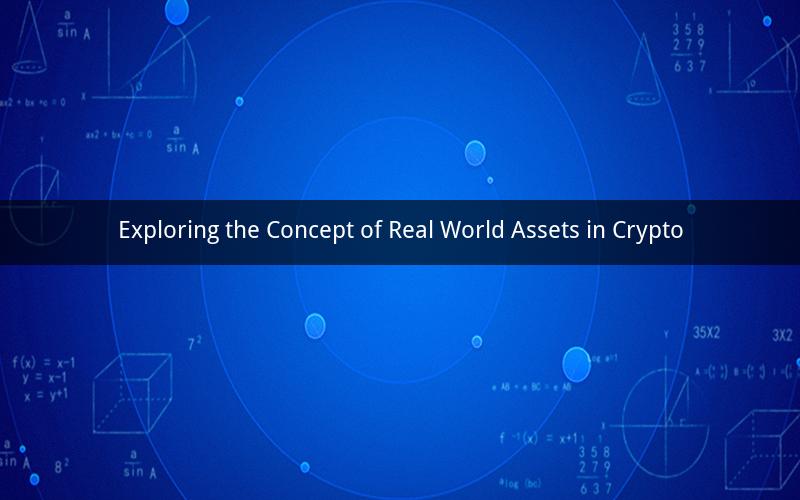
In the rapidly evolving world of cryptocurrencies, the integration of real-world assets has become a significant trend. Real-world assets refer to tangible or intangible assets that have a physical existence or value derived from the real world. This article delves into the concept of real-world assets in crypto, their benefits, challenges, and the future implications.
What are Real World Assets in Crypto?
Real-world assets in crypto are digital representations of physical assets or assets with real-world value. These assets can include real estate, gold, stocks, bonds, and other financial instruments. By tokenizing these assets, they can be bought, sold, and traded on blockchain platforms.
Benefits of Real World Assets in Crypto
1. Increased Accessibility
Tokenizing real-world assets makes them more accessible to a broader audience. Investors can now purchase fractional shares of real estate, gold, or other assets, which was previously not feasible due to high entry barriers.
2. Improved Liquidity
Real-world assets are often illiquid, meaning they cannot be easily converted to cash. By tokenizing these assets, liquidity is improved as investors can trade these tokens on decentralized exchanges (DEXs), allowing for quick and easy conversions.
3. Enhanced Security
Blockchain technology provides a secure and transparent platform for tokenizing real-world assets. The use of smart contracts ensures that transactions are executed automatically and cannot be altered, providing a high level of security for investors.
4. Lower Transaction Costs
Traditional financial systems often involve high transaction costs, including fees for brokers, banks, and other intermediaries. Tokenizing real-world assets eliminates the need for these intermediaries, resulting in lower transaction costs.
5. Reduced Counterparty Risk
Real-world assets in crypto reduce counterparty risk by eliminating the need for intermediaries. Transactions are executed directly between parties, ensuring that both parties fulfill their obligations without relying on a third party.
Challenges of Real World Assets in Crypto
1. Regulatory Hurdles
The integration of real-world assets in crypto is subject to various regulatory challenges. Governments and regulatory bodies around the world are still trying to determine the appropriate regulations for these assets, which can create uncertainty for investors and developers.
2. Scalability Issues
Blockchain technology is still in its early stages, and scalability remains a significant challenge. As more real-world assets are tokenized, the blockchain may struggle to handle the increased transaction volume, leading to slower transaction speeds and higher fees.
3. Trust and Credibility
Tokenizing real-world assets requires trust and credibility in the underlying platform and assets. Investors must have confidence in the authenticity and value of the assets being tokenized, which can be difficult to establish in a new and rapidly evolving market.
4. Technology Adoption
Adopting blockchain technology for tokenizing real-world assets requires significant investment and expertise. Many businesses and investors may not have the necessary resources or knowledge to implement these solutions, which can slow down the adoption process.
5. Market Volatility
The cryptocurrency market is known for its high volatility, which can impact the value of tokenized real-world assets. This volatility can make it challenging for investors to predict the future value of these assets, leading to uncertainty.
Future Implications
The integration of real-world assets in crypto is expected to have several future implications:
1. Increased Asset Class Diversification
Tokenized real-world assets will provide investors with a wider range of asset classes to choose from, allowing for increased diversification and potentially better risk-adjusted returns.
2. Cross-border Investments
Real-world assets in crypto will enable cross-border investments, allowing investors to invest in assets from around the world without the need for complex legal and regulatory frameworks.
3. Enhanced Market Efficiency
Tokenization of real-world assets will improve market efficiency by reducing transaction costs, increasing liquidity, and providing a more transparent and secure platform for trading.
4. Growth of the Crypto Ecosystem
The integration of real-world assets in crypto will drive the growth of the crypto ecosystem, attracting more investors, businesses, and developers to the market.
5. Potential for Disruption
Tokenized real-world assets have the potential to disrupt traditional financial systems by providing a more efficient, transparent, and accessible alternative for investors and businesses.
In conclusion, the concept of real-world assets in crypto offers numerous benefits, including increased accessibility, improved liquidity, enhanced security, lower transaction costs, and reduced counterparty risk. However, it also presents challenges such as regulatory hurdles, scalability issues, trust and credibility concerns, technology adoption challenges, and market volatility. Despite these challenges, the future implications of real-world assets in crypto are promising, with the potential to transform the way we invest and trade in assets.
Questions and Answers:
1. Q: What is the primary benefit of tokenizing real-world assets in crypto?
A: The primary benefit is increased accessibility, as it allows investors to purchase fractional shares of assets that were previously out of reach due to high entry barriers.
2. Q: How does tokenizing real-world assets improve liquidity?
A: Tokenization improves liquidity by allowing investors to trade these assets on decentralized exchanges (DEXs), which enables quick and easy conversions to cash.
3. Q: What are the main challenges faced by the integration of real-world assets in crypto?
A: The main challenges include regulatory hurdles, scalability issues, trust and credibility concerns, technology adoption challenges, and market volatility.
4. Q: How does tokenizing real-world assets contribute to the growth of the crypto ecosystem?
A: Tokenizing real-world assets drives the growth of the crypto ecosystem by attracting more investors, businesses, and developers to the market.
5. Q: What is the potential impact of real-world assets in crypto on traditional financial systems?
A: The potential impact is significant, as tokenized real-world assets could disrupt traditional financial systems by providing a more efficient, transparent, and accessible alternative for investors and businesses.